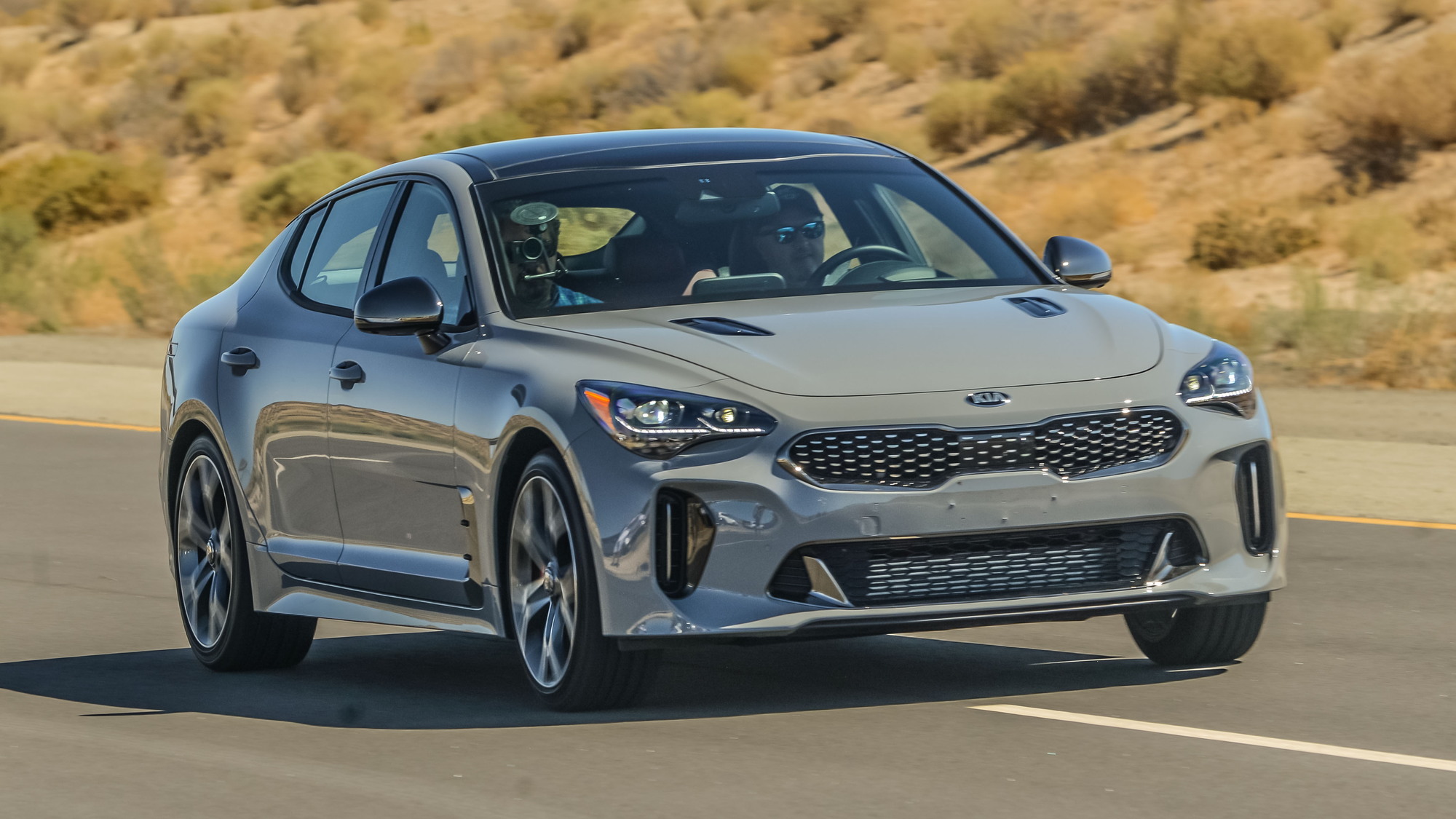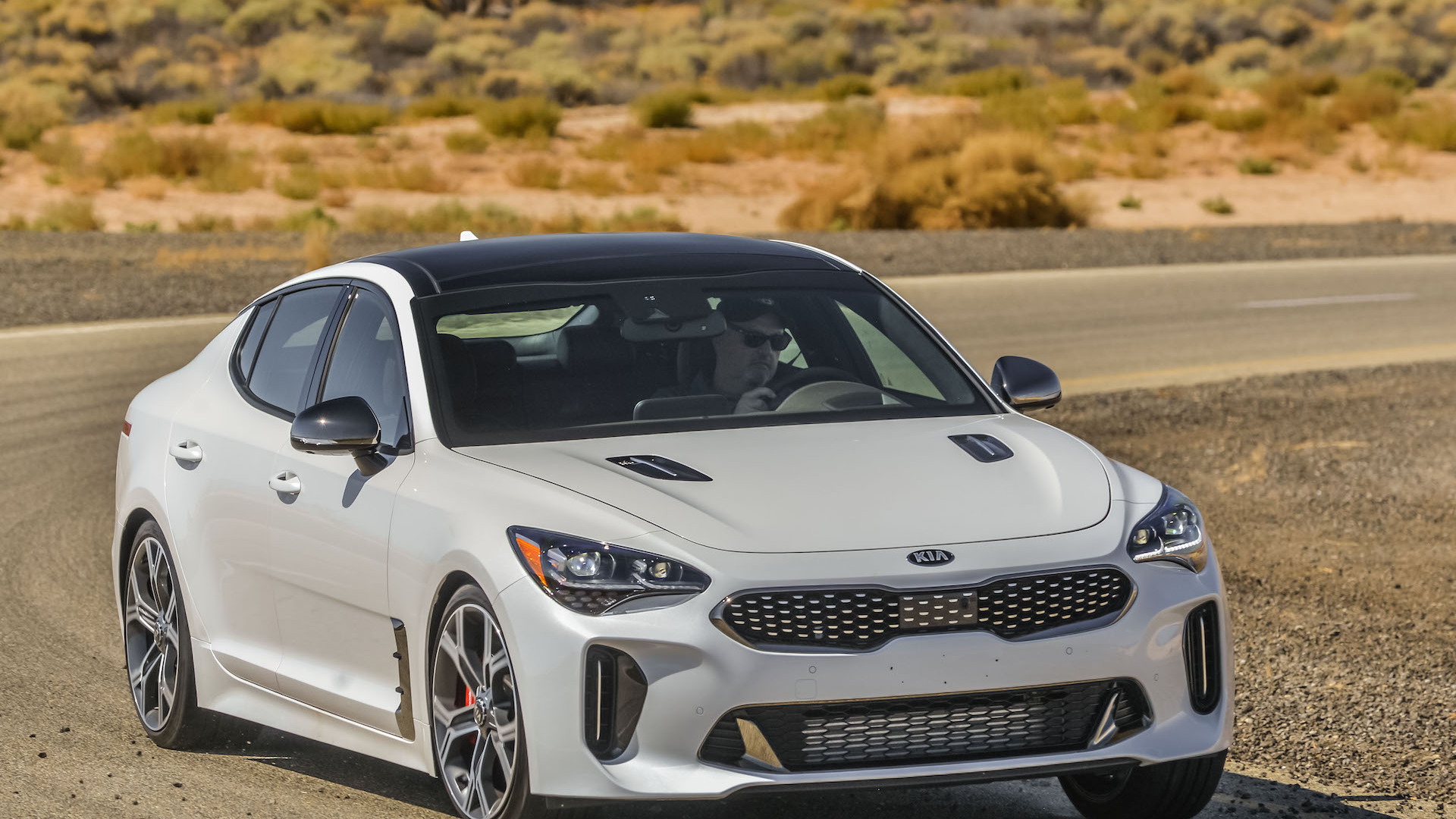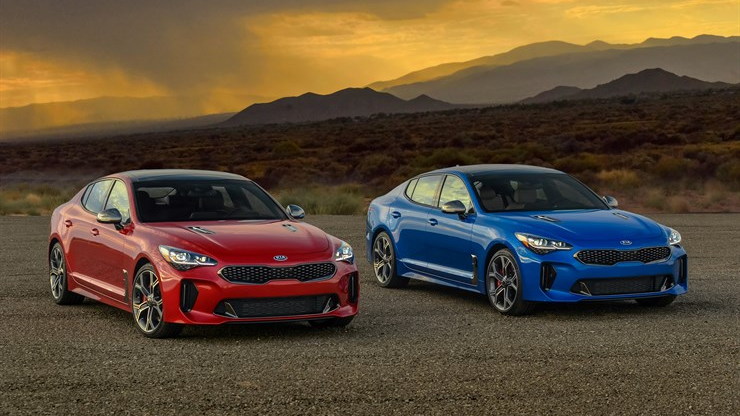Along its journey from builder of cheap but reliable transportation to budding luxury market player, Hyundai-Kia’s strategy has been “if you can’t beat them, join ‘em.” Or more appropriately, have them join you.
When its cars looked like poor imitations of melting Jaguars, Hyundai-Kia hired Audi designer Peter Schreyer to give its sheet metal some genuine style. The result was the 2010 Kia Optima, a car that injected verve into the usually staid mid-size sedan segment.
But that didn’t change the company's inability to tune a suspension. Or maybe it didn’t have the right parts to make a chassis work. Enter Albert Biermann in December 2014. As the former head of BMW M engineering, Biermann was tasked with making Hyundais, Kias, and the new high-end Genesis models sportier. The first car he developed from soup to nuts? The Kia Stinger.
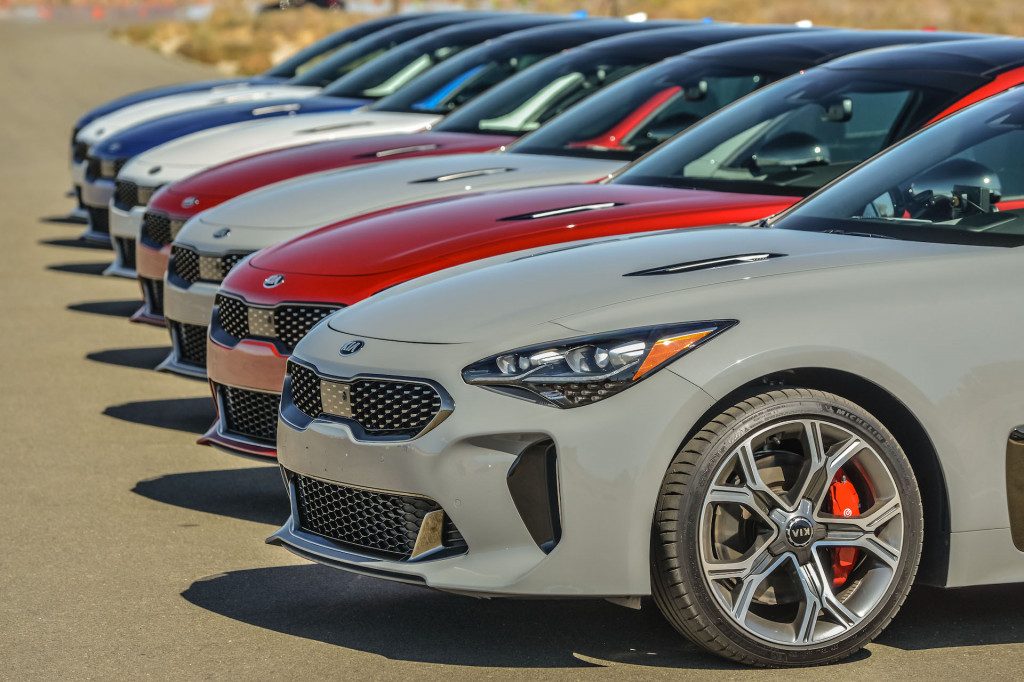
2018 Kia Stinger GT
An M influence
Biermann joined the company when the design for the Stinger was already underway, and Schreyer and his team had penned the attractive fastback lines inspired by cars like the 1970s Maserati Ghibli. “When I joined Kia, I said these cars need to drive as good as they look,” Biermann said in a company-produced video for the Stinger. The former M boss was happy to find that Kia had good parts to use. They just needed to be put together and tuned correctly.
And just what are those parts?
The GT model is best defined by its engine. Under its sculpted hood sits a twin-turbocharged 3.3-liter V-6 that develops 365 horsepower and 376 pound-feet of torque. It is mated to an 8-speed automatic transmission with steering wheel shift paddles. The base Stinger gets a turbocharged 2.0-liter 4-cylinder making 255 hp and 260 lb-ft of torque.
ALSO SEE: 2019 Audi A8 first drive review: technology enabling luxury
The body for every Stinger is comprised of 55 percent advanced high-strength steel, but it uses no light-weight materials like aluminum or carbon fiber. Hyundai is a steel company after all, so Hyundai Group vehicles will likely never use aluminum. Extensive use of structural adhesives helps stiffen the Stinger's body, as does a special structural ring around the rear hatch opening.
The front suspension relies on aluminum for the brace between the MacPherson struts. The rear end gets a five-link independent suspension mounted to a stiffened rear subframe. Electronically adjustable dampers, a Kia first, are used at all four corners for the Stinger GT, while 4-cylinder Stingers get static dampers. The brakes are Brembos, with 13.8-inch discs and four-piston fixed calipers up front and 13.4-inch discs and two-piston calipers at the rear. It all rides on a staggered set of 19-inch Michelin Pilot Sport 4 tires, 225/40s up front and 255/35s out back.
Kia offers the Stinger GT with rear-wheel drive or a rear-biased all-wheel-drive system that uses an electronically controlled clutch to shift up to 50 percent of the power to the front wheels. Put the Drive Mode Selector into Sport and up to 80 percent of the power can go to the rear. Rear-drive models are available with a mechanical limited-slip differential, while the AWD versions have a brake-based torque vectoring system that clamps down on the inside wheels to send power to the outside rear wheels in a turn.
Biermann's team made sure those parts were tuned correctly by extensively testing the Stinger GT. They subjected the car to more than 6,000 miles on the Nürburgring; performed braking runs on the Grossglockner, the highest mountain in the Austrian Alps; did winter testing in the Arctic Circle in Sweden; and conducted validation testing at the company’s California Proving Ground.
The Nürburgring testing revealed the car needed an engine oil cooler and an external transmission oil cooler to handle the rigors of track duty. It also got plenty of aero tweaks to make it work at its top speed of 167 mph. Among the aero elements are wheel air curtains with functional vents, gills behind the front wheels to reduce wake turbulence, a rear diffuser, a ducktail rear spoiler, and a belly pan. The result is a 0.30 cd. The horizontal ducts that flank the grille cool the brakes.

2018 Kia Stinger GT
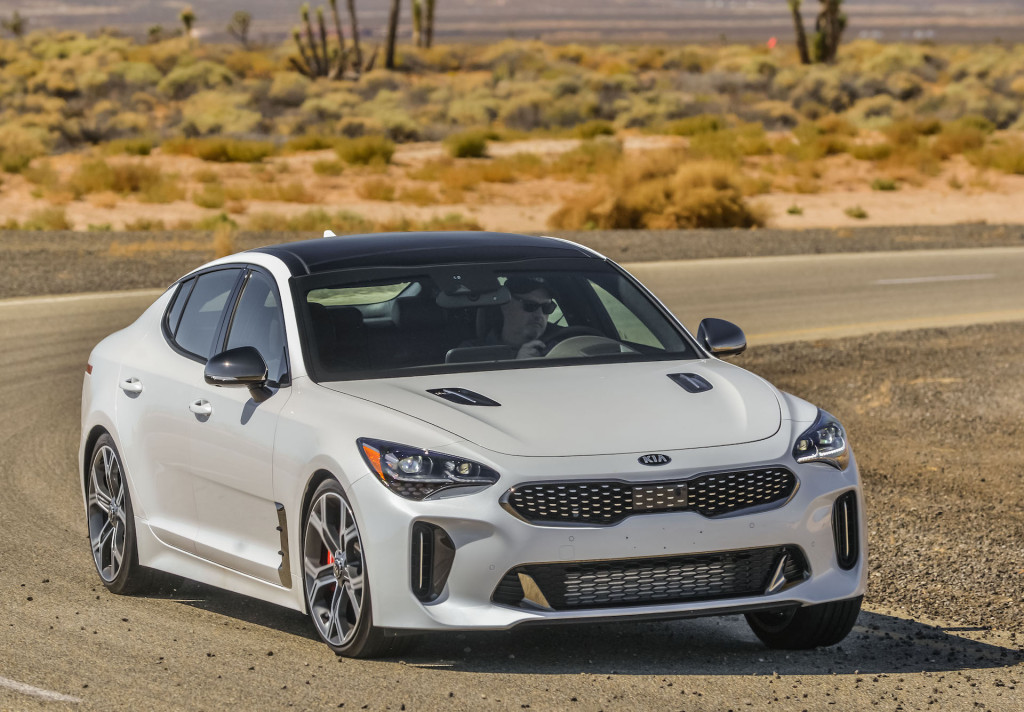
2018 Kia Stinger GT

2018 Kia Stinger GT
Challenging giants
You may have heard that the Stinger is a BMW 3-Series rival, but it’s bigger than that. At 190.2 inches long and with a 114.4-inch wheelbase, it’s larger than an Audi A5 Sportback. In fact, it’s just two inches shorter than the Lexus GS sedan but its wheelbase is two inches longer, and that makes it a mid-size car in our book.
But it’s not a sedan, either. It's a hatchback in the molds of the A5 Sportback, the Audi A7, or the Porsche Panamera. Kia counts all those cars among its competitors, along with cars like the BMW 4-Series Gran Coupe, the Lexus GS, and the Infiniti Q50.
CHECK OUT: 2018 Audi A5/S5 Sportback first drive review: a niche worth exploring
It may be bigger than the 3-Series, but it’s priced like it. In fact, it’s a bit cheaper with a starting price of $32,795 for the base model and $39,895 for the GT.
Kia’s test drive of the Stinger GT included a drive from West Hollywood west to the twisty Angeles Crest Highway and on to the company’s California Proving Ground in the Mojave Desert. At the proving ground, we did high-speed runs, an autocross with competitive vehicles, and laps around a road course.
How well does it compete with those cars, many of them giants of the luxury industry? From a value standpoint? It’s compelling. Dynamically? It’s in the ballpark, but there’s room for improvement.
Biermann's team got the basics right. Drive the Stinger GT hard into a corner on a track or a canyon road and it reacts well, with neutral, predictable handling. Get the speed under control with the strong Brembo brakes, and the Stinger rotates nicely through corners. The available limited-slip differential helps the car put down its prodigious power quite well coming out of turns, and the Sport mode lets the tail step out a bit.
However, there is room for improvement. While the steering is direct and predictable and the small, flat-bottom steering wheel feels appropriate for a sporty car, the Stinger GT’s turn-in isn’t especially immediate. A comparison drive on the autocross with the BMW 4-Series Gran Coupe revealed that the BMW is quicker to react. The Kia also doesn’t shift its weight that well from side to side when the turns get tighter. That’s likely due to carrying a bit too much weight and/or conservative damper tuning. The AWD system adds a bit more weight and exacerbates the issue. It feels like there is room for a more aggressive version of the Stinger than we get with the GT.
The suspension tuning is good, though. The ride quality is firm but never harsh, even in Sport mode. Speaking of the drive modes, this system adjusts not only the suspension, but also the throttle response, transmission, all-wheel-drive system, and stability control; the other modes are Eco, Smart (which learns your behavior), and Custom, which drivers can configure.
The Stinger GT’s greatest strength is its powertrain. The twin-turbocharged 3.3-liter V-6 helps the car punch above its weight. It lets out a refined howl and vaults the car from 0-60 mph in a scant 4.7 seconds. The full 376 lb-ft of torque comes on at a very low 1,300 rpm, so the punch is immediate. It works well with the 8-speed automatic transmission, especially in the Sport mode, which holds gears longer and quickens throttle response. On the track, however, the 8-speed got confused on a couple of short chutes that required full throttle application followed by hard braking, then back to full throttle. The transmission just didn't know what gear to be in and I had to wait for a beat for it to catch up on a couple of occasions. That can be remedied by using the smallish shift paddles behind the steering wheel.
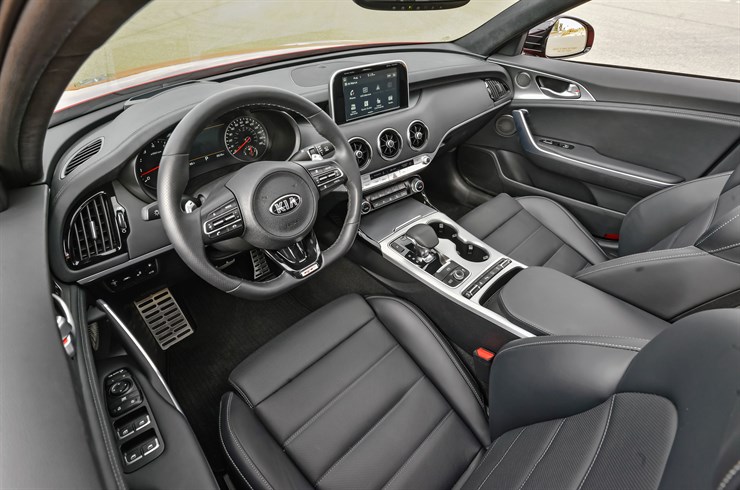
2018 Kia Stinger GT

2018 Kia Stinger GT

2018 Kia Stinger GT
Sporty, practical, and upscale
Hop in the Stinger GT and you will immediately be impressed by the quality of the cabin. Leather is standard and soft nappa leather is available. The supportive seats can be made even more supportive with optional air bladders, 16-way adjustments, and heating and ventilation. The dash is arrayed in a horizontal layout with a black wing-shaped dashboard offset by metal trim. A display in the instrument panel provides G forces and lap times, in true sporty fashion.
Plenty of amenities are available. Highlights include a head-up display; the Uvo3 infotainment system with navigation, Apple CarPlay and Android Auto; a heated steering wheel; and a thumpin' 720-watt, 15-speaker Harmon Kardon sound system with Clari-Fi that digitally expands compressed music and QuantumLogic Surround Sound that digitally approximates surround sound.

2018 Kia Stinger GT

2018 Kia Stinger GT

2018 Kia Stinger GT
The Stinger's hatchback body style and mid-size dimensions give it practicality, too. The back seats have good leg room for most adults and space for three across. Rear head room is generally good, but it will be limited for anyone taller than 6-feet due to the fastback roofline.
That roofline resolves into a hatch area that has 23.3 cubic feet of cargo space, which is half again as much as the trunk of a large sedan. Fold those rear seats down and storage space expands to 40.9 cubic feet, which is almost as much as a small SUV. That makes this car far more practical that any coupe or sedan.
Bottom line
Hyundai, Kia, and now Genesis have made a few efforts at building sporty rear-drive cars. It started with the Hyundai Genesis coupe back in 2008, then expanded to the Genesis sedan (now the Genesis G80) later that year. The Kia Stinger is the next attempt (soon to be followed by the Genesis G70 sedan, which is based on the Stinger), and this one is the best yet. It gets some of the smaller details right, and this time the basic suspension setup and handling character is on the money. There is, however, more room to grow to make the Stinger a true driver's car with the feel and reactions to challenge the Germans.
For now, though, the Stinger GT is fun to drive, powerful, practical, and upscale, and it all comes at a price that makes it a true bargain.
Kia paid for airfare and lodging for Internet Brand Automotive to bring you this first-hand report.

